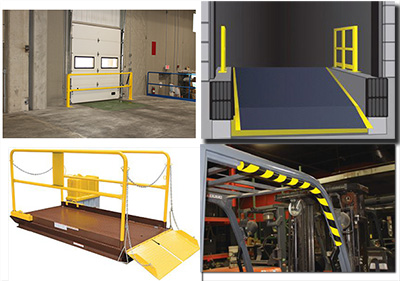Other Voices: Safety at the loading dock
The proper selection and usage of dock equipment can improve safety and productivity.

 Editor’s Note: The following column is by Brett Lindstrom, marketing and communications director for Systems, Inc., a manufacturer of loading dock equipment under the Poweramp, DLM and McGuire brands. This column is part of Modern’s Other Voices column, a series featuring ideas, opinions and insights from end-users, analysts, systems integrators and OEMs. Click here to learn about submitting a column for consideration.
Editor’s Note: The following column is by Brett Lindstrom, marketing and communications director for Systems, Inc., a manufacturer of loading dock equipment under the Poweramp, DLM and McGuire brands. This column is part of Modern’s Other Voices column, a series featuring ideas, opinions and insights from end-users, analysts, systems integrators and OEMs. Click here to learn about submitting a column for consideration.
Safety should always be a top priority for any business, but a company with loading docks should be particularly adherent to safety rules and regulations. Taking precautionary measures to prevent any accidents at the loading dock will create a safer working environment and reduce costs.
The American Supply Association reports that 25% of all industrial accidents occur at the loading dock, many of which are associated with the use of forklift trucks. According to OSHA, 96,785 forklift accidents at the workplace were reported in 2015. Of those, almost 35,000 (36%) caused either a serious injury or death. Many of these accidents are due to the forklift falling or driving over the edge of a loading dock. So how can this beprevented?
With loading docks, there are several elements to consider implementing:
- Install dock levelers
- Utilize vehicle restraints
- Have clear communication between dock attendants and truck drivers
- Add safety barriers
- Initiate and enforce training, regulatory compliance and best practices
When evaluating these categories, note that every warehouse, distribution center or other business type will vary in their requirements, but should all consider each aspect to some degree.
Dock Levelers
It’s an obvious statement to most, but every loading dock should have some form of dock leveler installed. Levelers act as a bridge between the warehouse and trailer, and can help prevent workers from falling between the two. Which dock leveler to install varies greatly based on a number of factors, as there are several types of levelers available.
Hydraulic levelers have generally proven to be the safest type of leveler due to their equipped components like a velocity fuse, which prevents the platform from free falling in the event of a trailer’s unexpected early departure from the loading dock. Regardless whether you want a simple edge-of-dock or need a pit-style leveler for more frequent and heavier loads, any dock leveler installed will help improve your safety and productivity.
Vehicle Restraints
Restraints are often considered an accessory to loading docks, but really they should be viewed as a standard component for safety. According to industry trends, on average 50% of levelers are sold with vehicle restraints. However, over the past five years the restraint market has been growing 14% each year, which is significantly more than levelers. What this all means is while there may be a large amount of loading docks without restraints installed, the number of docks with restraints continues to grow, indicating the industry’s shifting focus towards operational safety.
As previously mentioned, a primary reason for accidents at the loading dock are from forklifts driving or falling off the edge of the dock. This is often because a trailer is not secure to the dock and momentum from loading/unloading causes the trailer to creep forward, creating a potential gap between the dock and trailer. Simply using wheel chocks under the truck’s tire is a minimum requirement by OSHA on some trailer types, but installing mounted vehicle restraints can be safer and much more productive.
For effective vehicle restraints, consider the types of trailers that will be serviced at your docks. As an example, in the US a growing number of intermodal trailers are
being used. In fact, the Intermodal Association of North America reports that intermodal loadings grew from approximately 11 million in 2009 to approximately 17 million in 2016. Furthermore, they indicate that intermodal use is up 9% in 2017 over 2016.
This is important because many intermodal trailers have cover plates above the trailer’s Rear Impact Guard (RIG), which prevents some restraints from being
able to hold a secure engagement when force is applied from the trailer’s RIG during loading/unloading. To ensure an added level of safety, install a vehicle restraint that is universally effective on both regular trailers and those with obstructed rear impact guards, such as intermodal trailers with cover plates.
Light Communication
Another reason for accidents at the loading dock is caused by the truck prematurely departing from the dock. Once dock levelers and vehicle restraints are installed, add a light communication package usually provided with the leveler and restraint to notify both the truck driver and dock workers when it’s safe for either party to proceed. An effective light communication system will have an exterior red light and interior green light during the loading process. This indicates to the driver not to pull away, and to the dock workers that it is safe to enter the trailer. These lights can also be integrated with the leveler and restraint controls, so the lights will automatically change based on whether the restraint is securely engaged or not. They can also be triggered by the position of the dock leveler or door.
Some light packages also have a third cautionary amber light for scenarios such as restraint faults or when controls are in bypass mode. Other lighting systems have an option of red and green lights around the dock door. Either way, adding any light communication system can greatly increase safety at the docks.
Safety Barriers
From gates to bars to lips, safety barriers come in a variety of shapes and sizes. Yes, they can protect the dock door from being accidentally hit by a forklift, but in terms of safety the primary purpose of these barriers is to prevent workers and forklifts from falling off the dock edge. Simply put, if your business has a facility where you like to have the dock doors open without a trailer at the dock, strongly consider installing some kind of a safety barrier. As a matter of fact, depending on the distance of the drop to the ground, it can be an OSHA violation to not have some form of a safety barrier in place, leading to a potential fine.
Training and Regulations
The last component of a safe loading dock and work environment relies on the knowledge of the employees. Having all of the proper safety equipment in place is great, but if the workers don’t know how to operate or utilize that equipment, then it can still lead to accidents. First of all, obtain operational training from the suppliers or manufacturers of the loading dock equipment being used (leveler, restraint, controls, etc.). Read owner’s manuals and ensure everyone is aware of precautionary measures indicated by each of those vendors.
Secondly, have safety procedures in place for handling all equipment and emergency situations. For advice on workplace safety, review resources provided from such organizations as OSHA, industry associations you may belong to, or other reputable sources in your area. The Loading Dock Equipment Manufacturers (LODEM) group is also a great resource for industry information, such as educational documents on standard loading dock equipment. Regardless, have your safety procedures recorded in writing and make sure each employee has reviewed them.
Now you’re on your way to a more safe and efficient loading dock. Take the necessary measures to prevent as many accidents as possible. Install the right equipment and train your staff. Don’t become another negative statistic. Instead, become a resolution.

Article Topics
Blogs News & Resources
60 Seconds with Bob Trebilcock, outgoing executive editor, Modern Materials Handling Learn from lift truck service history Two voices of reason on pallet materials The reBound Podcast: How Pitney-Bowes is innovating with autonomous vehicles. Packaging Corner: Be open to change 60 Seconds with Robert Martichenko of American Logistics Aid Network The reBound Podcast: Looking for talent in all the right places: How Essendant is revolutionizing recruitment More BlogsLatest in Materials Handling
Registration open for Pack Expo International 2024 Walmart chooses Swisslog AS/RS and software for third milk processing facility NetLogistik partners with Vuzix subsidiary Moviynt to offer mobility solutions for warehouses Materials Handling Robotics: The new world of heterogeneous robotic integration BSLBATT is looking for new distributors and resellers worldwide Lucas Watson appointed CSO for Körber’s Parcel Logistics business in North America Hyster recognizes Dealers of Distinction for 2023 More Materials HandlingSubscribe to Materials Handling Magazine

Find out what the world's most innovative companies are doing to improve productivity in their plants and distribution centers.
Start your FREE subscription today.
April 2024 Modern Materials Handling

Latest Resources










